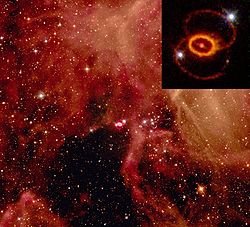Hubble Chronicles Brightening of Ring around Supernova 1987A (1994-2016 - crop, small)
Credits Video
NASA, ESA, Robert P. Kirshner (CfA, Moore Foundation), Peter Challis (CfA)This time-lapse video sequence of Hubble Space Telescope images reveals dramatic changes in a ring of material around the exploded star Supernova 1987A.
The images, taken from 1994 to 2016, show the effects of a shock wave from the supernova blast smashing into the ring. The ring begins to brighten as the shock wave hits it. The ring is about one light-year across.
Discovered in 1987, Supernova 1987A is the closest observed supernova to Earth since 1604. The exploded star resides 163,000 light-years away in the Large Magellanic Cloud, a satellite galaxy of our Milky Way. Credits Video
NASA, ESA, Robert P. Kirshner (CfA, Moore Foundation), Peter Challis (CfA)Das Material wurde für die NASA vom Space Telescope Science Institute unter dem Vertrag NAS5-26555 oder für die ESA vom Hubble European Space Agency Information Centre erstellt. Urheberrechtserklärung auf hubblesite.org oder 2008 Urheberrechtserklärung auf spacetelescope.org.
Für Material, das von der European Space Agency auf der Website spacetelescope.org seit 2009 erstellt wurde, verwende die Lizenzvorlage {{ESA-Hubble}}.Relevante Bilder



Relevante Artikel
SN 1987ASN 1987A ist die erdnächste Supernova, die seit der Supernova 1604 beobachtet werden konnte. Sie wurde am 24. Februar 1987 entdeckt und fand in der Großen Magellanschen Wolke (GMW) statt. Diese ist etwa 48.000 ± 5.000 Parsec entfernt, was rund 157.000 ± 16.000 Lichtjahren entspricht. .. weiterlesen
